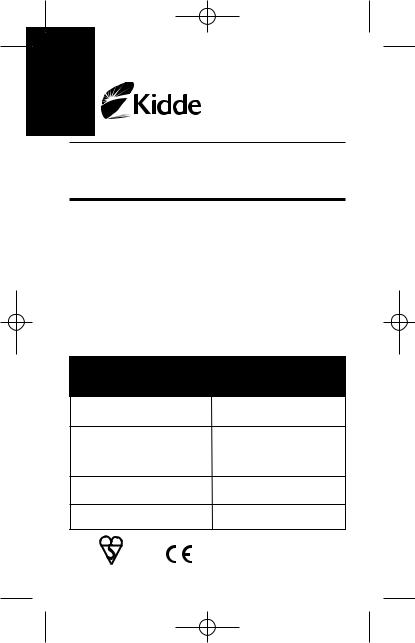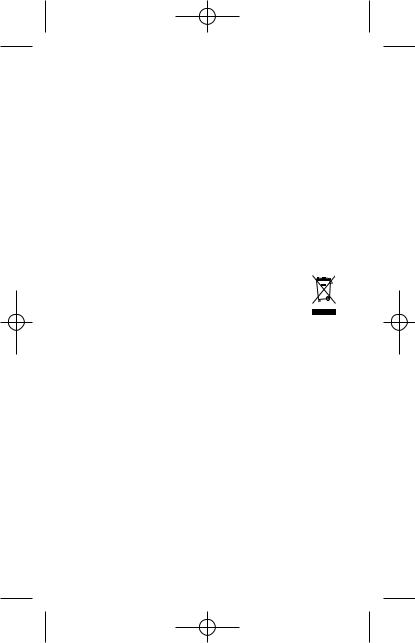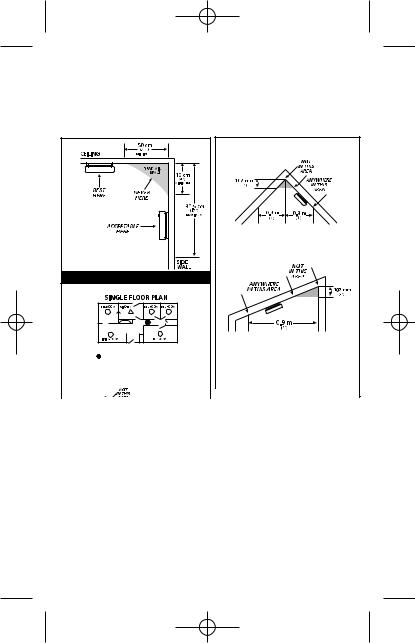Kidde 10Y29 User Manual

0308-7201-02(21008570B)_En.qxd:_ 2012.2.16 12:10 PM Pag
10Y29
For model: 10Y29
Smoke Alarm
User’s Guide
Lithium (non-replaceable sealed in) Battery-Operated Optical Smoke Alarm with HUSHTM Control to temporarily silence nuisance alarms.
Thank you for purchasing this smoke alarm. It is an important part of your family’s home safety plan. You can trust this product to provide the highest quality safety protection. We know you expect nothing less when the lives of your family are at stake.
Installation instructions and product information can be found within this manual.
For your convenience, write down the following information. If you call our Consumer Hotline, these are the first questions you will be asked.
Smoke Alarm Model Number (located on back of alarm):
Date Code (located on back of alarm): Kidde recommends replacing this alarm ten years from the date code.
Date of Purchase:
Where Purchased:
EN14604:2005 0086-CPD-535595
Licence No. KM524754
21008570 rev.B FHK P/N:0308-7201-02

0308-7201-02(21008570B)_En.qxd:_ 2012.2.16 12:10 PM Pag
Ionisation sensing alarms may detect invisible fire particles (associated with fast flaming fires) sooner than photoelectric alarms. Photoelectric sensing alarms may detect visible fire particles (associated with slow smouldering fires) sooner than ionisation alarms. Home fires develop in different ways and are often unpredictable. For maximum protection, Kidde recommends that both Ionisation and Photoelectric alarms be installed.
IMPORTANT! READ ALL INSTRUCTIONS BEFORE INSTALLATION AND KEEP THIS MANUAL NEAR THE ALARM FOR FUTURE REFERENCE.
CONTENTS OF THIS MANUAL
1 -- RECOMMENDED LOCATIONS FOR ALARMS
2 -- LOCATIONS TO AVOID
3 -- INSTALLATION INSTRUCTIONS
4 -- OPERATION AND TESTING
5 -- NUISANCE ALARMS
6 -- MAINTENANCE
7 -- LIMITATIONS OF SMOKE ALARMS
8 -- GOOD SAFETY HABITS
9 -- KIDDE RECOMMENDATIONS
10 -- SERVICE AND WARRANTY
ENVIRONMENTAL PROTECTION
Waste electrical products should not be disposed of with household waste. Please recycle where facilities exist. Check with Local Authority
or Supplier for recycling advice.
1. RECOMMENDED LOCATIONS FOR ALARMS
•Locate the first alarm in the immediate area of the bedrooms. Try to monitor the exit path as the bedrooms are usually farthest from the exit. If more than one sleeping area exists, locate additional alarms in each sleeping area.
•Locate additional alarms to monitor any stairway as stairways act like chimneys for smoke and heat.
•Locate at least one alarm on every floor level.
•Locate an alarm in every bedroom.
•Locate an alarm in every room where electrical appliances are operated excluding kitchens (i.e. portable heaters or humidifiers).
•Locate an alarm in every room where someone sleeps with the door closed.
The closed door may prevent an alarm not located in that room from waking the sleeper.
•Smoke, heat, and combustion products rise to the ceiling and spread horizontally. Mounting the smoke alarm on the ceiling in the center of the room places it closest to all points in the room. Ceiling mounting is required in ordinary residential construction.
•When mounting an alarm on the ceiling, locate it at a minimum of 50 cm (20”) from the side wall. (see Figure 1).
•When mounting the alarm on the wall, use an inside wall with the top edge of the alarm at a minimum of 10 cm (4”) and a maximum of 30.5 cm (12”) below the ceiling. (see Figure 1).

0308-7201-02(21008570B)_En.qxd:_ 2012.2.16 12:10 PM Pag
•Put smoke alarms at both ends of a bedroom hallway or large room if the hallway or room is more than 9.1 m (30 feet) long.
•Install Smoke Alarms on sloped, peaked or cathedral ceilings at or within 0.9 m (3 ft) of the highest point (measured horizontally). Smoke alarms in rooms with ceiling slopes greater than .3 m in 2.4 m (1 foot in 8 feet) horizontally shall be located on the high side of the room. A row of detectors shall be spaced and located within 0.9 m (3 ft) of the peak of the ceiling measured horizontally (see Figure 3).
FIGURE 1 |
Smoke Alarms for Minimum Protection
 Smoke Alarms for Additional Protection
Smoke Alarms for Additional Protection
 Heat Alarms for Additional Protection
Heat Alarms for Additional Protection
FIGURE 2 |
|
FIGURE 3 |

0308-7201-02(21008570B)_En.qxd:_ 2012.2.16 12:10 PM Pag
2.LOCATIONS TO AVOID
•In the garage. Products of combustion are present when you start your motor vehicle.
•Less than 50 cm (20") from a side wall.
•More than 0.9 m (3') from the peak of an "A" frame type ceiling (measured horizontally).
•Less than 102 mm (4") from the peak of an "A" frame type or sloped ceiling (measured vertically).
•In an area where the temperature may fall below 0ºC (32ºF) or rise above 40ºC (104ºF), such as garages and unfinished attics.
•In dusty areas. Dust particles may cause nuisance alarm or failure to alarm.
•In very humid areas. Moisture or steam can cause nuisance alarms.
•In insect-infested areas.
•Smoke alarms should not be installed within 3 ft (.9m) of the following: the door to a kitchen, the door to a bathroom containing a tub or shower, forced air supply ducts used for heating or cooling, ceiling or whole house ventilating fans, or other high air flow areas.
•Kitchens. Normal cooking may cause nuisance alarms.
•Near fluorescent lights, including CFL lamps. Electronic “noise” may cause nuisance alarms.
•Smoke alarms are not to be used with detector guards unless the combination (alarm and guard) has been evaluated and found suitable for that purpose.
3.INSTALLATION INSTRUCTIONS
CAUTION: THIS UNIT IS SEALED (INCLUDING THE BATTERY). THE COVER IS
NOT REMOVABLE!
When mounting |
|
in a hallway, the |
|
“A” line should |
|
be parallel with |
|
the hallway. |
|
|
When wall |
|
mounting, the |
|
“A” line should |
|
be horizontal. |
FIGURE 4 |
FIGURE 5 |
1. To ensure aesthetic alignment of |
Locati |
the alarm with the hallway or wall, |
|
the “A” line on the mounting |
|
bracket should be parallel with the |
|
hallway when ceiling mounting or |
Remove |
horizontal when wall mounting. |
Install |
FIGURE 6
